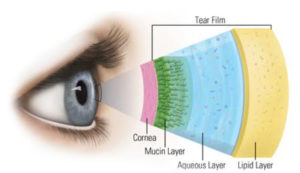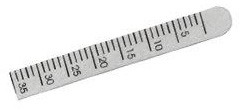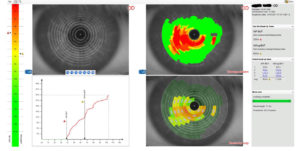1. What is dry eye?
 Dry eye is a condition in which a person doesn’t have enough quantity or quality tears to lubricate and nourish the eye. Dry eye is a common and often chronic problem, particularly in older adults. Often the condition gets aggravated after LASIK surgery.
Dry eye is a condition in which a person doesn’t have enough quantity or quality tears to lubricate and nourish the eye. Dry eye is a common and often chronic problem, particularly in older adults. Often the condition gets aggravated after LASIK surgery.
Tears spread over cornea with each blink. Tears provide lubrication, reduce the risk of eye infection, wash away foreign particles in the eye and keep the surface of the eyes smooth and clear.
2. What are tear film comprised of?
The tear film is made of three layers:
- An oily layer
- A aqueous layer
- A mucus layer
The oily layer is the outside of the tear film. It makes the tear surface smooth and keeps tears from getting evaporated too quickly. This layer is secreted from meibomian glands, which are situated in eyelids.
The aqueous layer or watery layer is the middle of the tear film. It makes up most of what we see as tears. This layer cleans the eye, washing away debris of the eye. This layer comes from the lacrimal glands.
The mucus layer is the inner layer of the tear film. This helps spread the watery layer over the eye’s surface, keeping it moist. Without mucus, tears would not stick to the eye. Mucus is secreted in the conjunctiva.
3. What are the causes of “dry eye”?
 Dry eyes can develop due to many factors, sometimes more than one factor acting.
Dry eyes can develop due to many factors, sometimes more than one factor acting.
1. Age. Dry eyes are a part of the natural aging process. Many people over age 65 years experience some symptoms of dry eyes. Women are more likely to develop dry eyes due to hormonal changes caused by pregnancy, use of oral contraceptives and menopause.
2. Medications. Certain medicines, including antihistamines, decongestants, blood pressure medications and antidepressants, can reduce the production of tear.
3. Medical conditions. People with rheumatoid arthritis, diabetes and thyroid problems are more likely to have symptoms of dry eyes.
4. Environmental conditions. Exposure to smoke, wind and dry climates can increase tear evaporation resulting in dry eye symptoms. Infrequent blinking such as when staring at a computer screen for long periods of time, can also contribute to drying of the eyes.
5. Other factors. Refractive eye surgeries like LASIK can decrease tear production and contribute to dry eyes.
4. What are the symptoms of Dry Eye?
Dryness, Itching, Burning, Sensitivity to light, blurry vision and watery eyes- are the common symptoms of Dry Eye.
5. Can “watery eyes” be a symptom of Dry Eye?
Yes. It sounds odd, but many patients of dry eye experience watering in their eye due to “Reflex tear secretion”. Tear gland overproduction occurs to compensate for lack of balanced tear film.
6. Can prolonged reading, Watching TV and prolonged Computer work cause Dry eye?
Yes. During reading, TV or Computer viewing, the rate of blinking of eyelids reduces significantly. This results in tear film evaporation, resulting in dryness of the eyes. It also causes fatigue and eye-strain.
7. What are the tests to diagnose/ Quantify Dry Eye?
Shirmer’s Test, Tear Film Break-Up Time measurement, NIF-BUT, Epithelial Staining pattern, TearLabTM Osmolarity, MMP-9 evaluation etc.
